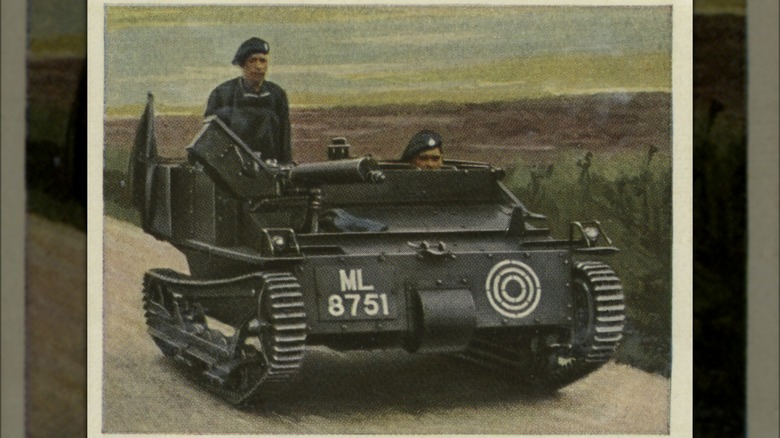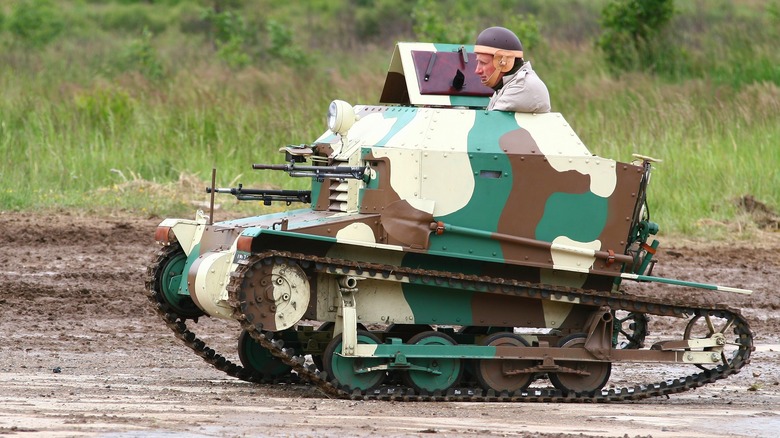A Mini Tank With Major Flaws: The Tankette Model 33
Tanks are supposed to be oversized, heavy beasts of war layered with thick armor, and bristling with a sizeable cannon. However, not all armored fighting vehicles boast that stereotypical profile. Take, for example, the Tančík vzor 33 (Tankette pattern 1933) — a miniature "tankette," if you will, used by the Czechoslovak military from 1934 until the end of World War II.
It was supposed to be a light reconnaissance and combat vehicle that could tow field guns, Howitzers, antitank guns, or ammunition, but it never met those expectations. In fact, it was such a disaster that it's considered one of the worst military tanks ever built.
This is odd since the Tančík vzor 33 (aka the P-1) was based on the British Carden-Loyd Mark VI tankette's very successful, and often copied, design. The armies from as many as sixteen other countries, including France, Belgium, Poland, Japan, Italy, and Russia, built similar tanks (i.e., the French UE, Polish TK, Japanese Te-Ke, Italian CV, Russian T-27) under license from Carden-Loyd.
In each case, the tankette was cheap to build, easy to maintain, adaptable, and in some cases, quick. For instance, the Italians — who know a thing or two about speed — called their version the Carro Veloce, which means "fast tank." In an October 1932 issue of Popular Science Magazine, Army experts claimed "that a fleet of these swift 'destroyers' could set up their mobile artillery in time to repel a surprise advance of enemy tanks."
The tiny tank that tanked
Except, that was hardly the case with the Tančík. Of the 74 that were made-to-order, more than half (40) were captured by German soldiers during the occupation of Czechoslovakia in 1939. So, what happened?
Despite several flaws apparent to the boots-on-the-ground soldiers, pressure was applied by politicians who saw how cheap it was to build. Lieutenant Colonel Bedřich Albrecht, who was in charge of the department that evaluated military innovations, visited the Carden-Loyd plant and was so impressed that he immediately recommended it to Czechoslovakia's Ministry of Defense.
The Ministry awarded Českomoravská Kolben-Daněk (ČKD) a license to build Carden-Loyd replicas, and purchase an additional three already built. All four subcontracted tanks were ready by September, but too late for "autumn field trials," so the three pre-builts were tested as soon as they were received. The results were not encouraging.
The tanks rode too low to the ground, getting stuck on obstacles and damaging the underside. Most roads were narrow and rutted by horse-drawn carts, so the tank's wide stance made navigating difficult, and often caused the treads to pop off entirely.
Since it was designed to be a light reconnaissance vehicle, the AFV was only armed with a single vz.24 heavy machine gun, but had an incredibly narrow firing arc. For some reason, additional ammunition was kept outside the tank in an external compartment (thus exposing the gunner to enemy fire), all of which made that machine gun all but useless.
'Tactically worthless'
Speaking of the crew ... the tankette's cramped interior was far from user friendly. The layout prevented the driver from seeing the gunner, and the engine was so loud they couldn't hear each other, making communication impossible. Furthermore, the ride was so rough due to lousy suspension that the occupants were routinely smacked against the inside of the hull.
Since the Tančík couldn't engage standard tanks, nor meet expectations of a reconnaissance vehicle, it was only marginally helpful in supporting infantry. The military deemed it all but useless because of its severally limited tactical capabilities. Still, Albrecht was sold on a promise from ČKD that it would improve the early versions to make them viable.
Several "fixes" were made that improved most issues. However, it still wasn't up to snuff, so another round of improvements was made that gave it better ground clearance, improved performance, increased armor thickness, rearranged the interior so the crew could communicate, and added a second machine gun to increase firepower.
Even after all that, military officials still considered the Tančík (now called the P-1) "tactically worthless," as described by Tank Encyclopedia. Albrecht, supported by Minister of Defense Bradáč, overruled their recommendations, saying everyone (including ČKD) had invested too much time and money to cancel the order that late in the game. The order was fulfilled, and the tankettes were used haphazardly and ineffectively throughout the war. It should come as no surprise that no original versions are believed to have survived.
[Featured image by Adam Hauner via Wikimedia Commons | Cropped and scaled | CC BY-SA 4.0]

